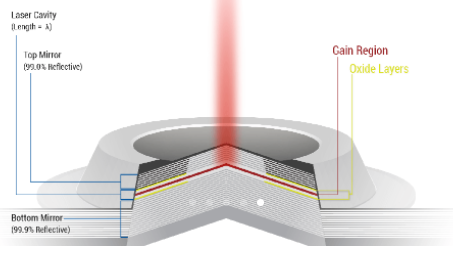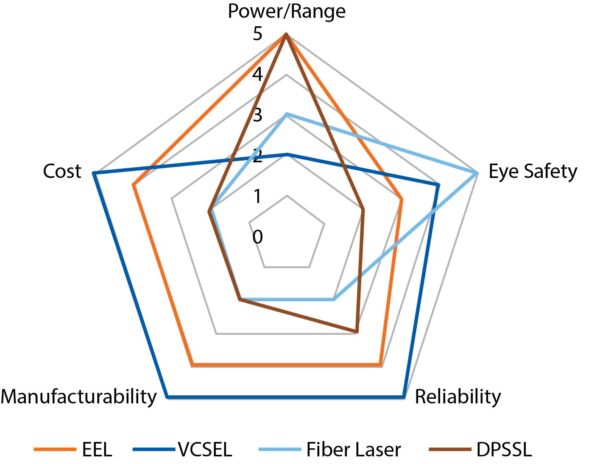Ever wonder how facial recognition has come around to be implemented in smartphones today? Vertical cavity surface-emitting lasers, (abbreviated VCSEL, pronounced “vixel”) are to thank for such a spy-like addition to smartphones! Their operating wavelength range covers 650-1080nm, 1300nm, and 1550nm, depending on the build materials used. The power they output can be anywhere on the order of mWs to Watts. VCSELs’ low power consistency make them ideal for face and gesture recognition. In contrast, their ability to generate higher power outputs would be more optimal for robotics and autonomous vehicle applications, which depend on LiDAR.
Thank you for the spec overview, but what exactly is VCSEL?
VCSELs typically make use of two epitaxial stacks of layers of a semiconductor material, like gallium arsenide. These stacks define the upper and lower Bragg reflectors that create the resonator cavity. Between these reflectors, there is a gain structure made up of quantum wells. This gain region amplifies the power and allows it to pass through the upper Bragg reflector to become a usable output. The figure below gives a visual representation:

VCSEL schematic showing main sections: bottom and top mirror stacks, laser cavity with gain region within oxide layers. Image courtesy of II-VI Inc.
VCSELs’ gain region is made up of quantum wells with a total thickness of a few microns. Since this gain region is rather small, it results in lower power, in the order of 0.5-5mW. One would think perhaps just increasing the gain region size would result in a higher power. However, larger gain regions run into the trouble of exciting higher-order transverse modes which do not allow for homogeneous pumping of said larger gain regions. Though a VCSELs smaller gain region limits the output power, the benefit of the smaller gain region is the ease of getting single-frequency operation with some ability to tune the wavelength. The smaller region also allows for VCSELs to be modulated at higher frequencies. This is ideal for telecom applications using optical fiber.
VCSEL technology is special in that the output beam quality is quite high, with low divergence. This does not mean a lens is not needed to control the light output, but it does mean light collimation can be achieved with less dependence on optics.
How do VCSELs compare to other light sources for such applications as 3D sensing for facial recognition?
3D sensing for facial recognition is a common occurrence now. It relies heavily on VCSEL technology and for a good reason. VCSELs are named for their innate ability to emit light outwards, perpendicular to the chip surface. This ultracompact geometry and high quality beam output makes VCSEL an ideal candidate for applications in smartphones.
The following schematic diagram compares the light spread straight from the chip of a VCSEL, a light-emitting diode (LED), and an edge-emitting laser (EEL). You can then see how adding a single non-diffusive lens to each of those light emitters affects the light distribution. The VCSEL is shown to maintain both a round beam shape and smooth intensity distribution throughout said beam shape. Similarly, an LED can produce a round beam, but it has an intensity drop close to the edges of the spot shape.

VCSEL, LED, and EEL light output from chip without lens, light output with lens, and beam profile. Image courtesy of Radiant Vision Systems
An LED used in this application would benefit from a lens with a diffusive surface to have even light intensity. That is an additional design consideration not necessary for VCSELs. You would think perhaps an EEL would be much better than the LED since it is a laser just like a VCSEL. On the contrary, the EEL’s uneven intensity distribution would also benefit from a diffusive optic. More concerningly, an EEL would require at least one additional optic to round out the beam shape. This can be done with a cylindrical lens or an anamorphic prism pair, but increases the package size. In this application, VCSEL tech is by far the preferred choice with minimal optical elements for compact package size and output, nice and ideal beam profiles.
How is VCSEL technology implemented for 3D sensing in smartphones?
The previous comparison of VCSEL, LED, and EEL sources add a sense of appreciation for the choices made in consumer electronics. For example, VCSEL technology is implemented in the iPhone X in the form of an array of VCSEL apertures on a chip. Commonly referred to as the “dot projector”, this array projects a pattern of infrared light onto the object being observed. The light output of each VCSEL in the array is evenly distributed and directed. This allows for a way more accurate recreation of a 3D mesh of the object from the signal coming back to sensors. Though used in the past for 3D sensing, LED light can’t keep up with VCSELs here. Since LEDs are harder to control/collimate in comparison to VCSEL light, they can’t enable 3D meshes of as high resolution as VCSELs.
Now you may be thinking “but won’t it be a concern that VCSELs give low power output?”, and with good reason. Power will not be a concern since what matters here is the quality of the signal. Additional filters/coatings here would further enable for the detectors being used to distinguish the NIR VCSELs’ signal more easily from other light, such as sunlight, and increase the signal-to-noise ratio for the detector.
On the topic of wavelength, manufacturers of VCSELs use test equipment to validate the output intensity and distribution of VCSELs. Since VCSEL outputs are invisible to the human eye, it is important to keep the laser operating parameters in mind. While short-term exposure may not be an issue, quality control is imperative to reduce harm to the human eye from exposure over time.
Can you talk about VCSELs applied in a currently advancing field, like LiDAR?
Can do! It always helps to investigate multiple applications of a specific tool, like a VCSEL, in order to have a more thorough understanding of its utility.
In this case, we will compare VCSELs to edge-emitting lasers (EELs), diode-pumped solid-state lasers (DPSSLs), and fiber lasers. When comparing VCSELs to these other lasers, VCSELs excel in manufacturability, reliability, cost, and eye safety, while not having as high output powers as other lasers. Fiber lasers may be comparable or surpass VCSELs in terms of safety. In terms of power range, EELs and DPSSLs definitively exceed past fiber lasers, but all these laser types leave VCSELs to bite the dust. All of these categories for evaluating laser types guide the laser selection depending on the specific LiDAR application.

Comparison of strengths different lasers have for LiDAR. Image courtesy of Photonics Media and Focuslight Technologies
VCSELs are the most promising in these high-volume applications. This is because of efficient coating, testing, and screening processes in VCSEL manufacturing. VCSELs have well-established their value as high-volume solutions in facial recognition in smartphones. LiDAR is a different challenge in that the distances over which VCSEL signal would “fly over” are much longer. Higher power here would definitively help to meet the higher demands of LiDAR systems. VCSEL manufacturers have developed VCSEL devices with up to eight junctions to generate higher power densities for such demands. VCSELs are definitively picking up steam to catch up to other lasers’ output power.
Since LiDAR is still advancing, what does the future for VCSEL technology look like right now?
After dominating the smartphone market, VCSEL technology is expected to continue advancing and adapting to cater to automobiles in LiDAR. VCSEL tech in automobiles might seem to be limited to LiDAR, but that is not the case! In-cabin monitoring, which enables the identification of vehicle occupants, would allow VCSELs to be “double-dipped” in automobiles. VCSEL manufacturers are also pushing for other advancements. Consider the term “back-emitting VCSEL designs”. Such designs would add flexibility in VCSEL manufacturing by reducing the wire bonding, allowing for faster rise and fall times. These types of advancements make it certain that VCSELs have yet to evolve to meet modern-day challenges.
Did you know that FindLight has an extensive category of VCSEL Lasers from leading manufacturers. If you are looking to but such a laser go explore our selection of VCSEL lasers now.
This post was sponsored by Gentec-EO: their newest MIRO ALTITUDE redefines accuracy and convenience in laser beam measurement.

Nice blog post. Thanks for sharing precious content, Awesome!!